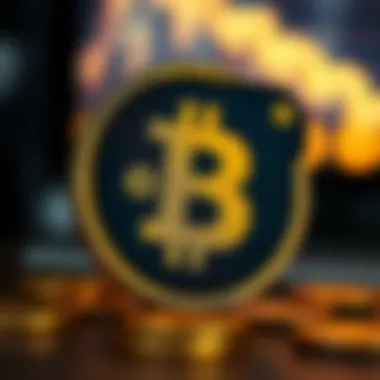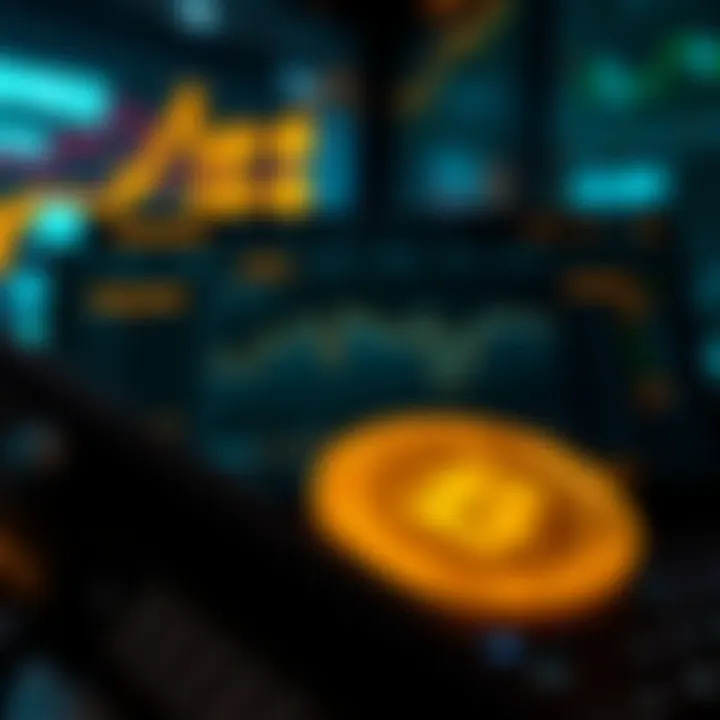How to Acquire a Binance Wallet: A Complete Guide


Intro
Navigating the intricate world of cryptocurrency can seem like a daunting task, especially for newcomers eager to dive into asset trading. However, having the right tools and knowledge can significantly ease this journey. That’s where a Binance wallet comes in. Binance stands out as one of the largest digital asset exchanges, known for its extensive selection of cryptocurrencies and user-friendly interface. Securing a Binance wallet is akin to having your own personal vault for your digital riches.
In this guide, we aim to simplify the process of acquiring a Binance wallet, unraveling the necessary steps, security measures, and wallet management strategies. The insights provided here will serve not just as a roadmap for beginners but also as a refresher for seasoned crypto enthusiasts. Let’s dive into the foundational concepts that will equip you with a solid understanding of the cryptocurrency landscape.
Understanding Cryptocurrency Wallets
When stepping into the vast ocean of cryptocurrency, one of the first things you’ll encounter is the concept of wallets. In this landscape, a wallet isn’t like your everyday leather wallet, stuffed with cash and cards. Instead, it’s a vital tool that allows you to store, manage, and transact your digital assets securely. The importance of understanding cryptocurrency wallets can't be stressed enough, especially when venturing into platforms like Binance.
Cryptocurrency wallets serve multiple roles; most notably, they hold your private keys, which are necessary for accessing your funds. Without them, it's akin to having a bank account without a PIN. Understanding how wallets work is crucial because it gives you the foundation to manage your crypto effectively. There are benefits and certain considerations that come along with this understanding that can shape how you interact with the crypto world.
For example, the flexibility of accessing your assets through different wallet types allows you to choose a solution that fits your needs, whether you're trading frequently or just holding long-term. Additionally, knowing the unique features of various wallets helps in making informed decisions about where to park your digital coins. Ultimately, this lays the groundwork for the subsequent sections where we’ll delve deeper into Binance wallets specifically.
Overview of Binance
When it comes to navigating the cryptocurrency world, Binance stands out like a lighthouse for those shipwrecked in a stormy sea. It’s one of the largest cryptocurrency exchanges in the world. Understanding Binance is not just a matter of curiosity; it’s crucial for anyone looking to dive into using a Binance wallet. The exchange offers a plethora of options and features, making it more than just a place to buy and sell digital assets.
Intro to Binance
Launched in 2017, Binance quickly skyrocketed to fame, capturing the attention of traders and investors alike. Why, you ask? For starters, it was designed with both novice and seasoned users in mind. Its platform is relatively straightforward, yet packed with advanced functionalities. Binance aims to be a one-stop-shop for all things cryptocurrency, allowing users to explore a wide range of currencies and trading pairs. The platform supports more than 500 cryptocurrencies—talk about putting the eggs in one basket!
Why Choose Binance for Your Wallet
Choosing Binance for creating a wallet comes with numerous advantages. It’s not merely about storing cryptocurrencies; it’s about doing so in a secure, efficient, and user-friendly environment. Here's a closer look at a few elements that contribute to its appeal:
Security Features
When it comes to security, Binance doesn’t pull any punches. The platform employs a robust multi-tier and multi-cluster system architecture to better protect user data and funds. One of the standout aspects is its two-factor authentication (2FA), ensuring that you have an extra layer of security. While no system is foolproof, Binance's continuous commitment to improving its security protocols makes it a solid option for securely managing digital assets. It’s akin to having a strong lock on your front door; it won’t stop all intruders, but it sure makes it harder for them to get in.
User Interface
Binance sports a user interface that caters to both newcomers and experienced traders. The straightforward layout allows new users to grasp the essentials without feeling like they’ve been thrown into the deep end. Advanced features are easily accessible, yet they don’t clutter the user experience. The interface encourages exploration without overwhelming new users. Imagine being in a well-organized library where finding the book you want is a breeze; that’s how Binance feels when you’re navigating it.
Range of Supported Cryptocurrencies
With more than 500 cryptocurrencies to choose from, Binance offers diversity that few others can match. Whether you're interested in Bitcoin, Ethereum, or lesser-known altcoins, you can find it all in one place. This extensive range allows users to diversify their portfolios easily and take calculated risks. For traders keen on having options, this variety is a boon, making Binance the Swiss Army knife of crypto trading.
Integration with the Binance Exchange
The ability to seamlessly integrate your wallet with the Binance exchange is a significant benefit. It’s like having a direct train line to an essential destination—no need for layovers or complicated transfers. You can buy, sell, and trade your assets without the hassle of moving them around to different platforms. This enhances the overall user experience and allows for quicker transactions, which are critical in the fast-paced world of cryptocurrency.
Setting Up a Binance Account
Setting up a Binance account is crucial for anyone looking to dive into the cryptocurrency landscape. This process serves as the gateway to managing various digital assets effectively. Without a valid account, you can't interact with the exchange or your wallet, which limits your ability to trade or hold cryptocurrencies.
A well-configured Binance account allows users to benefit from enhanced security features, easy access to a myriad of cryptocurrencies, and seamless integration with Binance trading functionalities. The steps to register and verify an account may seem tedious at first, but they are essential for ensuring a safe trading experience. Let's take a closer look at the registration process.
Registration Process
Creating an account is the first step in establishing your presence in the crypto world. While this step may seem straightforward, there are important nuances worth considering.
Creating Your Account


Creating your account on Binance involves entering your email and a password, along with a few other necessary details. What sets this process apart is how quickly you can get started; you can do it in a matter of minutes. This immediacy is one of the key characteristics that makes creating an account attractive.
Moreover, the user-friendly design of the registration form contributes to its popularity. You don’t need to be a tech guru to navigate it. However, it’s not just a matter of entering data; you need to also consider the implications of your email selection, as a compromised email can lead to a compromised account. So, tread carefully here.
Email Verification
Email verification is another critical aspect that comes next. This step not only validates your identity but also helps protect against unauthorized access. Once you’ve created your account, you’ll receive a verification link in your email. Clicking this link becomes your gateway to a functioning account.
The unique feature of this verification process is that it adds an extra layer of security right from the start. While some may find this added step annoying, it’s a beneficial choice as it drastically reduces the risk of impersonation or account takeovers. Not verifying your email opens you up to unwanted risks, making this step non-negotiable.
Setting a Secure Password
Next, setting a secure password is fundamental in safeguarding your assets. Binance requires a minimum character length and encourages the use of mixed-case letters, numbers, and special characters to create a strong password. This step is essential—think of your password as the first line of defense against hackers.
Incorporating a robust password reduces vulnerability, but it’s equally important to keep it private. The choice of creating a memorable yet secure password is beneficial; something that sticks with you but isn’t easily guessed. Managing this is straightforward, yet the ramifications of a weak password can be severe, so take this seriously.
Account Verification
Once your basic account setup is done, account verification takes the process a step further. This step is not only about regulation but also about your personal security and the security of the Binance platform.
Identity Verification
Identity verification involves substantiating who you are through document uploads like a government-issued ID. While some may view this as an invasion of privacy, it effectively combats fraud and ensures compliance with financial regulations. This layer of verification is what makes Binance trustworthy and facilitates higher trading limits.
Furthermore, this process enables you to recover your account in case of loss, which is an absolute lifesaver. The drawback? It can take several hours to days for your documents to be reviewed, which can feel like an eternity if you’re eager to get started.
Two-Factor Authentication
Lastly, enabling Two-Factor Authentication adds an essential layer of security to your account. Even if someone were to obtain your password, they wouldn't be able to access your account without the second factor, which typically involves a code sent to your mobile device.
This unique feature enhances security significantly and is now seen as a standard practice in digital asset management. The real advantage? It’s relatively easy to set up and adds a robust defense against unauthorized access. The downside is that you need to have your mobile device handy, so if you accidentally misplace it, you may run into some hiccups while trying to access your account.
In summary, setting up a Binance account is a critical step in engaging with cryptocurrency. The registration and verification processes, while sometimes cumbersome, are designed to protect you and your assets while allowing you to benefit from the wide array of services offered by Binance.
Creating a Binance Wallet
Creating a wallet on Binance is a fundamental step for anyone looking to actively engage in the world of cryptocurrencies. It's like setting up your own digital fortress, ensuring that your assets are safe from unwarranted access while allowing you to manage and trade as you please. By establishing a wallet on Binance, you're not just opening a door to various cryptocurrency dealings; you're also given the responsibility of securing your digital assets. The process, while straightforward, requires attention to detail and understanding of the various choices involved.
Wallet Generation Process
Accessing the Wallet Section
To get started, finding the wallet section is your first task. Once you're logged into your Binance account, this section is clearly labeled and easily accessible. This is a critical starting point for wallet creation; it's where you can initiate the setup process. A pivotal characteristic of this section is its user-friendly layout, which caters to both novices and seasoned users alike. Because many users might feel overwhelmed at first, the intuitive design helps alleviate potential confusion. Another noteworthy feature is the guidance provided along the way, which can be quite beneficial if you're not fully versed in the technical aspects of crypto.
Choosing a Wallet Type
Once you're within the wallet section, the next step is to choose the type of wallet that fits your needs. Binance offers multiple types, each designed for different levels of security and accessibility. A critical characteristic here is the balance between security and convenience. Hot wallets, for example, allow for swift transactions and ease of access, making them popular for active traders. On the flip side, cold wallets provide enhanced security by storing your assets offline, although they may require more effort to access funds during trading. Choosing the right type hinges on your trading style, risk tolerance, and how often you plan on interacting with your assets.
Generating Your Wallet
Finally, generating your wallet is the last step in setting up. This contrasts with simply choosing a wallet type because it involves actual creation and setup. During wallet generation, you typically receive a mnemonic phrase or a private key, an expression of paramount importance in crypto security. The notable feature here is that this is a one-shot deal; losing access to this information can mean losing your funds. Hence, it’s prudent to securely back up this information, ideally in multiple formats, avoiding cloud storage or digital forms that may be compromised. The process is designed for optimal safety, ensuring that once your wallet is live, it's as fortified as it can be against external threats.
Understanding Wallet Addresses


Address Formats
When you dive into cryptocurrency trading, understanding wallet addresses becomes pivotally important. Different cryptocurrencies possess unique formats for their wallet addresses, often comprising a string of letters and numbers of varying lengths. A standout characteristic of these formats is their inherent complexity — they serve as a digital fingerprint for transactions. This unique design is beneficial, offering a layer of anonymity and specificity. However, it also demands diligence; sending coins to an incorrect address can result in irreversible losses.
Receiving Cryptocurrency
Receiving cryptocurrency is the lifeline of wallet functionality. It’s essential to be familiar with how this process works to avoid pitfalls. The unique feature of this function is it allows for seamless transactions between wallets, enabling individuals to transfer assets globally in seconds. To receive funds, you typically use your wallet address, which acts like an email for money. This procedure is straightforward, yet understanding it completely improves your overall experience in managing your assets and can ensure that you avoid common mistakes. Proper comprehension makes dealing in cryptocurrencies not just easier, but safer too.
"Getting familiar with wallet addresses and the process of receiving cryptocurrency can set you apart in the fast-evolving landscape of digital finance."
In summary, each element involved in creating a Binance wallet plays a crucial role in supporting your journey through the crypto world. From accessing the wallet to understanding addresses, every step builds your command over your digital assets.
Security Measures for Your Wallet
When it comes to cryptocurrency, security isn’t just a nice-to-have; it’s essential. With the increasing popularity of digital currencies, the number of targeted attacks has skyrocketed. In this context, understanding security measures becomes crucial for anyone looking to manage their assets safely. Employing effective security protocols can significantly reduce the risks associated with hacking, theft, and other vulnerabilities that can endanger a Binance wallet.
Best Practices for Wallet Security
Keeping Private Keys Safe
The private key is like the crown jewels of your cryptocurrency wallet. If someone gets their hands on it, they can access your funds without breaking a sweat. That's why safeguarding this key is fundamental. The best practice is to ensure that your private keys are stored offline, away from the prying eyes of potential hackers. Utilizing hardware wallets or paper wallets can significantly enhance security.
A unique aspect of keeping your private keys safe is the peace of mind it provides. By ensuring they’re not just lying around digitally where malware can snatch them, you take control of your wallet's security. This creates a beneficial environment for users who may not be so tech-savvy yet want to keep their hard-earned money secure.
Using Secure Internet Connections
Not every Wi-Fi signal is created equal. It’s important to connect to secure networks, especially when accessing your Binance wallet. Public Wi-Fi networks might feel convenient, but they often lack sufficient security measures. Hackers can easily intercept data transmitted over unencrypted connections, making it a risky affair for any wallet owner.
By choosing to use a VPN or relying on secure home or business networks, you fortify your defense against such vulnerabilities. This not only prevents unauthorized access but also ensures your transactions remain confidential. Connecting to trusted networks is undoubtedly a smart tactic for safeguarding your assets.
Regularly Updating Software
Software updates might seem like an annoyance, but they often come with vital security patches. Keeping the wallet software, antivirus, and overall operating systems current helps you stay one step ahead of potential threats. Cybercriminals can exploit vulnerabilities in outdated software, which is why regular updates should be part of your security routine.
It's also worth noting that many platforms, including Binance, push updates that enhance functionalities. So, not only do you get better security, but also improved features that make managing your wallet more efficient. Staying updated is crucial for keeping malicious intrusions at bay and maintaining an optimal wallet experience.
Recognizing Common Threats
Understanding the nature of threats is as crucial as implementing security measures. The cryptocurrency landscape is littered with potential pitfalls, and knowing how to navigate through them can make all the difference. Two primary threats are prevalent in today’s digital realm: phishing attacks and malware risks.
Phishing Attacks
Phishing attacks generally involve tricking the user into providing sensitive information, such as private keys or account credentials. Through deceptive emails or websites mimicking Binance, attackers aim to lull individuals into a false sense of security. This specific aspect makes phishing one of the most common threats, as it preys on user error rather than exploiting technical vulnerabilities.
Being aware of these scams can significantly bolster your defenses. Always double-check URLs and avoid clicking on unfamiliar links. Awareness of phishing strategies is beneficial; it equips users with the knowledge to navigate securely, thus reducing the likelihood of falling victim.
Malware Risks
Malware can manifest in different forms, from viruses to spyware, all designed with an ill intent. Such malicious software can compromise your system and, ultimately, your wallet. This aspect of malware risks makes it a highly pertinent topic in any discussion regarding cryptocurrency safety.
The unique feature of malware risks is that they can often infiltrate systems subtly. Regular scans and using credible antivirus programs can help mitigate these risks. Educating yourself on recognizing suspicious applications and ensuring you download from reputable sources are crucial steps in safeguarding your assets.
Keeping security measures at the forefront of your mind is not just a precaution; it’s a necessity in today’s digital landscape.


Managing Your Binance Wallet
Managing your Binance wallet is an essential aspect of engaging with cryptocurrency, and paying attention to this part can enhance your overall experience. A well-managed wallet ensures your assets are secure, easily accessible, and positioned for optimum growth. Understanding various components, like transferring funds and tracking your portfolio, can elevate your trading and investment game significantly.
Transferring Funds
Transferring funds into and out of your Binance wallet is crucial for facilitating trading activities. Getting the hang of this process can save you time and keep your operations smooth.
Depositing to Your Wallet
When it comes to Depositing to Your Wallet, the ease of doing so plays a key role. By transferring funds from an external source into your Binance wallet, you set the stage for trading, investing, or simply holding your digital assets. The straightforward process allows you to acquire cryptocurrencies quickly, catering to both novice and seasoned traders.
One of the standout characteristics of this deposit process is the wide variety of supported currencies. This diversity grants you the flexibility to choose from numerous tokens, broadening your investment opportunities.
The unique feature you should watch out for is the instant deposit feature. This means that funds are made available almost immediately, letting you jump into trading right away. However, it’s important to note that transaction fees can vary depending on the currency or method chosen. Always check the Binance fee schedule to gauge those costs upfront, so you avoid any surprises.
Withdrawing from Binance
On the flip side, Withdrawing from Binance is equally important. This capability allows you to transfer your assets back to an external wallet or fiat. Understanding the withdrawal process is essential for managing your liquidity, especially if you're looking to cash out.
A key aspect here is the speed of withdrawals. Binance employs an efficient system to process requests, usually ensuring that your funds are in your desired account shortly after initiation. This reliability makes it a popular choice among traders who need quick access to their funds.
The standout feature of withdrawals is the choice between crypto and fiat withdrawals. This flexibility enables you to adjust your strategy as market conditions shift. However, keep in mind that there may be limits and fees based on the amount you wish to withdraw and the method employed, so planning ahead will help avoid complications.
Tracking Your Portfolio
Keeping an eye on your assets is vital in the fast-paced world of cryptocurrency. Tracking your portfolio provides insights necessary for making informed decisions about your trades.
Using Binance's Tools
Utilizing Binance's Tools for portfolio tracking can be a game changer. The platform provides a comprehensive suite of features designed to help you monitor your investments efficiently. The user-friendly interface makes it easy to access real-time data and analytics.
The notable characteristic of these tools is the integration with trading accounts. This means you can analyze your performance across various assets all in one place. It makes decision-making a breeze, whether you’re shifting assets or doubling down on what’s working.
One unique advantage of using Binance's internal tools is the immediate access to market trends. These analytics can help you anticipate movements, allowing for proactive adjustments. However, some users may find the reliance on a single platform limiting, as external factors or personal preferences might urge a more diversified approach.
Third-Party Portfolio Trackers
On the other hand, considering Third-Party Portfolio Trackers can equally add value to your tracking efforts. These tools offer additional perspectives and can cater to a variety of trading styles, giving you more flexibility in your management.
A critical feature is the customizable dashboards. These trackers allow you to personalize how you view your investments, streamlining your daily review process. This can be particularly beneficial for advanced traders who may want detailed insights into specific market segments.
However, one should be cautious about data privacy when using third-party services. They often require access to your exchange accounts and associated wallets. Weighing the pros and cons is key; a robust tool might offer enhanced insight but could also introduce personal information risks.
In summary, effectively managing your Binance wallet encompasses more than just the deposits and withdrawals. It also involves the critical task of tracking your portfolio, which can help you make well-informed investment decisions. Always keep security considerations at the forefront of your management strategy.
Closure
In the ever-evolving landscape of cryptocurrency, having a reliable and efficient wallet like Binance is pivotal. This guide has highlighted not just the steps to get your hands on a Binance wallet, but also the importance of understanding its intricacies for managing digital assets securely and effectively.
Recap of Key Points
Through this article, several vital elements have been emphasized. First, it is crucial to comprehend the different types of wallets available. Recognizing the distinctions between hot and cold wallets may save you from potential pitfalls. Next, the registration process and subsequent verification steps cannot be overstated; these are your first line of defense against fraud and unauthorized access. We also detailed security measures that users must adopt; safeguarding your private keys and utilizing secure internet connections are fundamental practices that can mitigate risks. Finally, managing your wallet effectively—be it through tracking your portfolio or transferring funds—ensures that you remain in control of your investments.
Further Resources and Reading
For those desiring to deepen their understanding of cryptocurrency wallets and the Binance platform, several resources are invaluable:
- Binance Academy: academy.binance.com offers a plethora of tutorials and articles on cryptocurrency fundamentals and trading strategies.
- Investopedia: investopedia.com can help you grasp foundational concepts around digital currencies and financial literacy.
- Reddit Cryptocurrency Subreddits: Engaging in communities like r/CryptoCurrency can provide real-world insights and experiences from fellow investors and traders.
- Wikipedia: A great starting point for foundational knowledge is Bitcoin on Wikipedia, where you can learn about the first cryptocurrency's history and underlying technology.
Equipping yourself with the right information and resources ensures that you navigate the world of cryptocurrency wisely. As the market continues to grow, staying informed becomes paramount.















